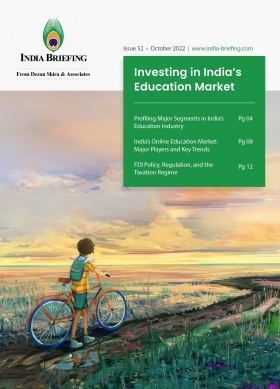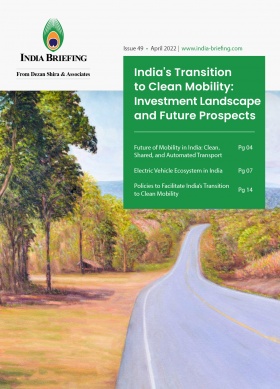India Finalizes INR 160 Billion Sovereign Green Bonds Framework to Fund Green Projects
India recently finalized its Sovereign Green Bonds Framework to boost its renewable energy transition. The federal government will finance projects and initiatives in nine broad categories, including renewable energy, energy efficiency, and clean transportation, through its INR 160 billion (US$1.6 billion) worth green bond offering in FY 2022-23 and future issuances. Foreign investors must note that payments of principal and interest on the issuances under India’s Sovereign Green Bond Framework are not conditional on the performance of the eligible projects and investors do not bear any project related risks.
On November 9, 2022, the federal government approved the Sovereign Green Bonds Framework of India. Through the framework, the government aims to issue green bonds worth INR 160 billion (US$1.6 billion) from October 2022 to March 2023. The Sovereign Green Bonds Framework will ensure availability of finance for green infrastructure and renewable energy projects, with focus on funding solar power projects, followed by wind and small hydro projects.
It is touted as a big step towards achieving India’s commitment towards its Nationally Determined Contribution (NDCs) targets adopted under the Paris Agreement 2016.
As per a recent McKinsey report titled ‘Decarbonizing India: Charting a Pathway for Sustainable Growth’, to decarbonize, India can accelerate green investments to US$12.1 trillion by 2050 and reap a host of benefits. The sovereign green bonds are expected to attract higher global and domestic investments to eligible green projects in India.
The Sovereign Green Bonds Framework is rated ‘Medium Green’ with a ‘Good’ governance score by Norway-based independent second opinion provider CICERO. It must be noted that the ‘Medium Green’ rating is assigned ‘to projects and solutions that represent significant steps towards the long-term vision, but are not quite there yet.
What are green bonds?
The Green Bond Principles (Voluntary Guidelines for Issuing Green Bonds) by the International Capital Markets Association (ICMA) define a green bond as any type of instrument where the proceeds or an equivalent amount will be exclusively applied to finance or re-finance, in part or in full, new and/or existing eligible green projects. As per these principles, green bonds may include:
- Standard green bonds: A recourse-to-the-issuer based debt obligation.
- Green revenue bonds: A non-recourse-to-the issuer-based debt obligation. Here, credit risk exposure under the instrument is pledged to the project revenue flows.
- Green project bond: A recourse/non-recourse-to-the issuer debt obligation. Here, the borrower has direct risk exposure for green project(s).
- Green securitised bond: A bond backed by green project(s), with the primary repayment source being the project revenue flows.
The only significant difference between green bonds and ordinary bonds is that the funds raised from investors are only used to support environmentally sustainable initiatives, such as green construction, renewable energy, etc.
According to reports by the London-based Climate Bonds Initiative, by the end of 2020, 24 national governments had issued sovereign green, social, and sustainability bonds totaling a cumulative US$111 billion.
What is the Sovereign Green Bond Framework?
The Sovereign Green Bonds Framework charts India’s obligations as a green bond issuer and applies to all sovereign green bonds issued by the federal government. First announced during Union Budget 2022-23, green bonds are to be a part of the Indian government’s overall market borrowings with the proceeds to be deployed in public sector projects that help in reducing the carbon intensity of the economy.
Investors must note that payments of principal and interest on the issuances under India’s Green Bond Framework are not conditional on the performance of the eligible projects and investors do not bear any project related risks.
What are the main components of the Sovereign Green Bond Framework?
The Sovereign Green Bond Framework will comply with four components and key recommendations of the ICMA Green Bond Principles (2021). The principles recommend a clear process and disclosure by the issuer to enable investors, banks, and others to understand the characteristics of the green bond. The four key components of the framework, as outlined by the Green Bond Principles, are stated below.
Use of proceeds
A ‘green project’ classification is based on the following principles:
- Encourages energy efficiency in resource utilization
- Reduces carbon emissions and greenhouse gases
- Promotes climate resilience and/or adaptation
- Values and improves natural ecosystems and biodiversity – especially in accordance with Sustainable Development Goals (SDG) principles
The Sovereign Green Bond Framework lists the following nine categories as falling under the eligible category. The eligible expenditure is limited to government expenditure that occurs a maximum 12 months prior to the issuance of green bonds.
|
Green project category |
Environmental objective |
Eligibility criteria |
|
Renewable energy |
Climate change mitigation Net zero objectives |
Investments in solar/wind/biomass /hydropower energy projects that integrate energy generation and storage Incentivizing adoption of renewable energy |
|
Energy efficiency |
Climate change mitigation
|
Design and construction of energy-efficient and energy saving systems and installations in government buildings and properties. Supporting public lighting improvements Supporting construction of new low-carbon buildings as well as energy-efficiency retrofits to existing buildings Projects to reduce electricity grid losses. |
|
Clean transportation |
Climate change mitigation
|
Promote public transportation including its electrification and transport safety Subsidies to adopt clean fuels like electric vehicles including building charging infrastructure |
|
Climate change adaptation |
Climate change adaptation |
Projects aimed at making infrastructure more resilient to impacts of climate change, as well as investments in information support systems, such as climate observation and early warning systems. |
|
Sustainable water and waste management |
Climate change mitigation
|
Promoting water efficient irrigation systems Installation/upgradation of wastewater infrastructure including transport, treatment and disposal systems Water resources conservation Flood defense systems. |
|
Pollution prevention and control |
Climate change mitigation Environment protection |
Projects targeting reduction of air emissions, greenhouse gas control, soil remediation, waste management, waste prevention, waste recycling, waste reduction and energy/emission-efficient waste-to-energy |
|
Green buildings |
Climate change mitigation |
Projects related to buildings that meet regional, national, or internationally recognized standards or certification for environmental performance |
|
Sustainable management of living natural resources and land use |
Natural resource conservation |
Environmentally sustainable management of agriculture, animal husbandry, fishery and aquaculture Sustainable forestry management including afforestation /reforestation Support to certified organic farming |
|
Terrestrial and aquatic biodiversity conservation |
Biodiversity conservation |
Projects relating to coastal and marine environments Projects related to biodiversity preservation, including conservation of endangered species, habitats and ecosystems |
Which projects are excluded from this list?
- Projects involving new or existing extraction, production and distribution of fossil fuels, including improvements and upgrades; or where the core energy source is fossil-fuel based
- Nuclear power generation
- Direct waste incineration
- Alcohol, weapons, tobacco, gaming, or palm oil industries
- Renewable energy projects generating energy from biomass using feedstock originating from protected areas
- Landfill projects
- Hydropower plants larger than 25 MW
- Expenditures directly related to fossil fuel
Project evaluation and selection
For the purpose of project selection and evaluation, the government has constituted a Green Finance Working Committee (GFWC), which will meet at least twice a year to support the Ministry of Finance with selection and evaluation of projects and other relevant work related to the Framework.
Once the GFCW has been constituted, the project selection will be done through the following stages:
Initial selection of eligible projects and expenditures
Relevant Line Ministries will conduct an internal evaluation to come up with a list of eligible projects based on the Framework in addition to their level of preparedness (1= Ready for investment, 2= Under Development, 3= Under Conceptualization). Each of the projects will carry metrices to best define their environmental and social impact.
Assessment and evaluation of final set of eligible expenditures
At this stage, GFCW will evaluate the entire list of submitted projects for their adherence to the framework, and their alignment with green objectives. The GFCW will seek opinion of subject matter experts.
Management of proceeds
The proceeds will be deposited to the Consolidated Fund of India (CFI), and then funds from the CFI will be made available for eligible green projects. The Public Debt Management Cell (PDMC) will keep a track of proceeds within the existing guidelines regarding debt management and monitor the allocation of funds towards eligible green expenditures. Unallocated proceeds, if any, will be carried forward to successive years for investment in eligible green projects only. The government will ensure that all proceeds are allocated within a span of two years from the date of issuance.
Reporting mechanisms
The Allocation Report will be brought under GFWC supervision and must be updated until full allocation of proceeds of outstanding green bonds. In case of any material changes, it must be updated to the effect.
The annual report is expected to consist of the following:
- Information about issuance
- List of allocated proceeds to eligible projects and type of expenditure (tax, subsidies etc.)
- Alignment of the eligible procedures with stated objectives
- Description of projects financed and their status of implementation
- Total quantum of proceeds generated, allocated and remaining unallocated (if any)
- Assumptions made, if any
- Expected impact of the projects in quantitative indicators (to the extent possible), indicating reduction in carbon intensity, other environmental benefits and, where possible, social co-benefits
About Us
India Briefing is produced by Dezan Shira & Associates. The firm assists foreign investors throughout Asia from offices across the world, including in Delhi and Mumbai. Readers may write to india@dezshira.com for more support on doing business in in India.
We also maintain offices or have alliance partners assisting foreign investors in Indonesia, Singapore, Vietnam, Philippines, Malaysia, Thailand, Italy, Germany, and the United States, in addition to practices in Bangladesh and Russia.
- Previous Article A Look at India’s Long-Term Climate Action Strategy
- Next Article Appointment and Removal of Independent Directors in India: Alternate Mechanism Notified








